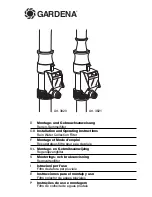
OFITE, 11302 Steeplecrest Dr., Houston, TX 77065 USA / Tel: 832-320-7300 / Fax: 713-880-9886 / www.ofite.com
14
Working Pressure
OFITE clearly stamps the working pressure of the cell assembly along with
the assembly serial number on each cell body and cell cap. These pressure
limits should never be exceeded on the pressure manifolds and fluid vol
-
umes inside the cell should strictly comply with instructions (see page 23).
However, in the past HTHP cells and caps from various manufacturers were
often not stamped, or in some cases, very old cell assemblies were stamped
“2500”. Cell assemblies with set screw secured caps should never be taken
to 2,500 psi, under any temperature or condition.
The OFITE 175 mL HTHP Filter Press (#170-00 and #170-01) are furnished
with a standard 1500 psi working pressure cell assembly. OFITE also manu
-
factures HTHP cells with a 2,000 psi working pressure. Please note the 1,500
psi and 2,000 psi cell assemblies do not have parts that are interchangeable,
so when ordering replacement cell caps for instance, know which working
pressure rated cell assembly you are ordering for.
Cell Cap, 1,500 psi, Set Screws: 0.75 inch thick
Cell Cap, 2,000 psi, Set Screws: 0.94 inch thick
Locking Set Screws
Locking set screws should have sharp points on the end. If the tip becomes
worn and flattened, pressure may be lost in the cell or the cell cap may be
-
come damaged. Any set screw cell cap that has elongated set screw holes
should be discarded as they are unsafe.
Locking Screw for HTHP Cell
Caps 2,000 psi, 90 Cone Point
(#170-26-1)
#170-69 Cell Cap, 2,000 psi,
HTHP Filter Press Scribed For
Ceramic Filters. Note: Round
Set Screw Holes
O-ring Seals
The choice of o-rings, or elastomers as they are commonly called, is very
important in any high temperature high pressure environment. OFITE uses
Viton o-rings, a copolymer of Vinylidene, which are less pliable than some
Buna rings which may be encountered from other manufacturers, but they
withstand the higher temperatures better than the Buna rings. The maximum
temperature for the Viton o-rings is 400°F (204°C). OFITE suggests that all
o-rings (cell caps, cell bodies, and valve stem) are changed each time after
running a test of 350° F (176° C) or above.
















































